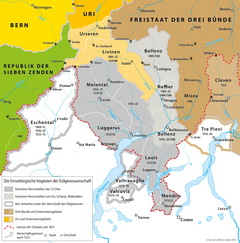Eternal direction with France
The Eternal direction with France or Eternal Peace - in the Romandie after the place of its conclusion Friborg Traité de Friborg called - was a signed on 29 November 1516 permanent peace treaty. The treaty agreed between the Kingdom of France under King Francis I and the Thirteen Old Places of the Confederation with its associated places (the Abbey of St. Gallen , the Three Leagues , the Republic of Valais and the city of Mulhouse in Alsace ) sealed the peace after the Battle of Marignano, which took place in 1515 during the wars of Milan and was lost by the Confederates .
Starting position

In the battle of Marignano, which took place on September 13 and 14, 1515 in the Italian Lombardy , the federal armies were devastated by the troops of the French king, King Francis I. The battle was one of the last major battles in which the Old Confederation took part.
Contract negotiations
The farsighted and indulgent French victor, King Francis I, was keen to get the Confederates permanently on the French side. The peace negotiations were held first in Geneva and later in Freiburg. They ended on November 29, 1516 with the signing of a peace treaty. Although the French king was able to largely dictate the conditions after his victory in the Battle of Marignano, historians consider the peace treaty to be relatively generous towards the confederates.
What is remarkable about the peace treaty is that in addition to the thirteen Swiss Confederation towns, related towns were also involved.
Content of the contract

With the peace treaty, the Confederates gave up their claims to the protectorate of Milan and King Franz took control of Lombardy . In addition, the contracting parties waived the support of opponents of the other party.
France paid the confederates war compensation of 700,000 kroner. This corresponds to about 2.5 tons of gold, as well as an annual pension of 2,000 kroner for each federal location, the Valais and the Three Leagues.
Despite the offer of a further 300,000 kroner, the Confederates and the Three Leagues did not renounce their Eennet mountain bailiffs (without Bellinzona). As a result, the Confederates and their allies were definitively awarded the Ennet mountain possessions of Bellinzona , Lugano and Locarno as well as the Valtellina and Chiavenna . In this way, the area of what would later become the canton of Ticino became part of the Swiss Confederation , and Mendrisio from 1521. Only the Eschental and Luino , which lie south of the Simplon Pass , were not allowed to be kept by the Confederates.
The peace treaty was written in early New High German in the Confederation's copy and in Latin in the French document. These two copies are kept in the Freiburg State Archives and in the Archives nationales in Paris. The contract bears the seal of the thirteen places (in protocol order: Zurich, Lucerne, Bern, Uri, Schwyz, Unterwalden, Zug, Glarus, Basel, Freiburg, Solothurn, Schaffhausen and Appenzell).
Pay alliance of 1521
In 1521 the Confederates and the Kingdom of France agreed on a pay alliance in Lucerne. The French king was given the right to pay at least 6,000 and a maximum of 16,000 Swiss warriors to France in the event of a “war of defense”.
Zurich did not, unlike in 1516, sign the contract, but the cities of Biel and Rottweil, which were connected to it . The reformed Zurich, shaped by the reformer Ulrich Zwingli , held back from rapprochement with deeply Catholic France for economic, but especially for religious reasons. Ulrich Zwingli, who took part in the battle of Marignano as a field preacher, was also very critical of the pay service.
End of the Eternal Direction
The end of the Eternal Direction was de facto the occupation of the country by French revolutionary troops in 1798 during the French invasion, with the disempowerment of the patriciate and the establishment of the Helvetic Republic . In the course of the French Revolution , the French king was executed and nobody felt bound by the old treaties anymore.
Effects on the Confederation
The Eternal Direction marked the beginning of the French period in Swiss history, the period in which the Confederation came more and more under the political, cultural and economic influence of the French royal family. Together with the pay alliance of 1521, the Eternal Direction was the beginning of a new foreign policy orientation for the Confederation towards France. Until the French Revolution, this was to be a central constant in federal foreign relations and an important factor in domestic policy. The two treaties brought the Confederation , which soon thereafter became patrician , a largely undisturbed, close relationship with absolutist France for centuries . As recently as 1789 , when the Parisians stormed the Bastille, federal mercenaries were involved in the unsuccessful defense attempt.
In the 19th century, the defeat of Marignano was then reinterpreted as the beginning of Switzerland's neutrality policy .
literature
- Handbook of Swiss History (collaborator: Hanno Helbling et al.). 2 volumes. Zurich 1972/1977, ISBN 3-85572-021-5 .
Web links
- André Holenstein: Eternal Peace. In: Historical Lexicon of Switzerland .
- State Archives Freiburg: Eternal Peace
- Early New High German wording of the contract
Individual evidence
- ↑ Christophe Büchi: 500 years of "Eternal Peace" Switzerland-France: When the Confederation tilted west. In: Neue Zürcher Zeitung . 26th September 2016.
- ↑ Video-Explainer on "Eternal Peace": Battle lost, but won anyway In: Neue Zürcher Zeitung . November 26, 2016.
- ↑ With halberds against cannons: Blind into Verderben - Marignano 1515. In: Neue Zürcher Zeitung . March 20, 2015.
- ^ Freiburg State Archives: On the wording of the contract. In: fr.ch. Retrieved October 15, 2016 .
